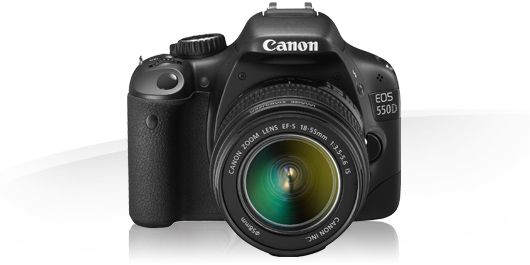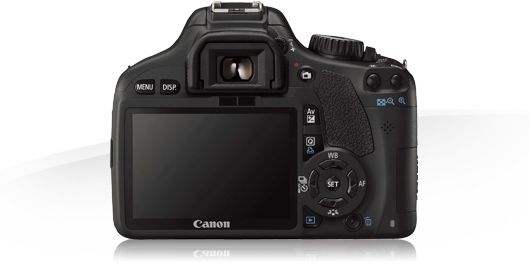Table of Contents
amazon Canon 550D reviews
If you have used previous Canon models such as the 450D or 500D, then you will not be surprised with the 550D upgrade. The body of both the battery and the memory card has a total weight of 540 grams with three dimensions of 129 x 98 x 62 mm, not much different from the “predecessor” 500D. The rugged, robust and slippery, rubberized slider sleeve is slim-coated. The button system on the back is small but very sensitive. In return, the thumb position is designed quite widely. Live View and Movie Recording are now individually integrated on a key located to the right of the viewfinder, making the transition mode convenient and accurate. The 550D’s LCD still maintains a 3-inch display, but the resolution has risen from 920,000 pixels at 500D to 1,040,000 pixels – the highest among DSLRs on the market today. This also means that the 550D can display 15% more detail than its predecessor. The screen size is adjustable to a 3: 2 ratio of the sensor, which means that images in Live View mode and the viewfinder will fit into the frame.
Similarly to the previous version, the Canon 550D is not equipped with additional LCD display parameters. All manipulation is always through the screen behind the machine. The interface of the 550D is similar to the “predecessor” 500D with visual icons and relatively eye-catching. The navigation menu is not too deep so it is easy to familiarize with the beginners.
The 550D’s optical viewfinder has a magnification of 0.87x and a 95% coverage of the frame, similar to the “predecessor” 500D, but slightly smaller than the Nikon D90. The 550D owns a 9-point autofocus system that is diamond-shaped. Testing on three Canon lenses including 15-85mm F / 3.5-5.6 IS USM, 50mm F / 1.4 USM and 100mm F2.8L IS Macro shows: Single servo AF mode works very fast and accurate, especially When the focus point moves back to the center. The steady-focus mode when working with fast-moving subjects.
The most grievable thing is probably the speed of focus based on contrasting contrast when the live viewfinder is activated. Under good lighting conditions, the camera takes nearly a second to lock the object. This time increases to 4-5 seconds if the environment is dim. When changing to the Quick mode, speed and accuracy are significantly improved. In return, the screen will not display when the camera is in focus, very inconvenient if your subject moves. The 550D lets you magnify images up to 10x on the LCD screen to support manual focus or autofocus accuracy. It also supports live view through the TV screen with HDMI connection or through the computer screen with EOS Utility software.
The Canon 550D uses an 18 megapixel CMOS sensor that is said to be “almost” identical to the EOS 7D’s premium model. The continuous shooting speed of the camera is impressive, although the resolution has reached the “threshold” among cameras using the APS-C sensor. The 550D allows about 3.7 shots per second, approx. Nikon D90 (4 frames per second) and slightly above 500d (3.4 fps). However, Canon seems to have forgotten to improve its cache capacity, saving only up to 34 JPEGs high resolution or 6 RAW images. This figure on the “predecessor” 500D is 170 JPEGs or 9 RAW images.
The Canon 550D features a 63-zone iFCL metering sensor, which is a premium device on the mid-range EOS 7D. Color information is combined with data from the AF sensor to produce accurate results regarding the range and movement speed of the main subject in the frame. According to Ephotozine, the metering system of the 550D works perfectly under normal lighting conditions. With high contrast settings (sky – ground, indoor – outdoor …), the machine tends to slightly older exposure. You can solve this problem by subtracting some Ev or activating the Auto Lighting Optimiser.
where can you get a Canon 550D online
Canon EOS 550D (European EOS Rebel T2i) 18 MP CMOS APS-C Digital SLR Camera with 3.0-Inch LCD and EF-S 18-55mm f/3.5-5.6 IS Lens (Body & Lens made in Japan): Buy it now
Canon EOS 550D (European EOS Rebel T2i) 18 MP CMOS APS-C Digital SLR Camera, Made in Japan (Body): Buy it now
Similar to DSLR models launched in recent years, the 550D is equipped with an analog / digital 14 bit switch system. Thus, each output channel of the 550D is capable of transmitting up to 16,384 colors, which is four times higher than the 400D version. Theoretically, the 550D is capable of delivering smoother and more accurate color reproduction than traditional 12-bit models. The 550D offers excellent image quality with high contrast and sharpness. JPEG images are fresh. The large resolution of the sensor also makes it easier for users to crop and print larger images.
The ISO range of the machine is in the range of 100 to 6,400, extending up to the H level corresponding to ISO 12,800. Although the resolution of the sensor up to 18 Megapixel noise is still very good control even if ISO up to 800. The 550D has the ability to eliminate noise and retain the parity Nikon D90. Note, the midrange model of Nikon only 12 megapixel resolution, which is less than 6.0 MP compared to the Canon 550D. Even better, the 550D has better color reproduction than the D90 at high ISO settings.
The 550D’s white balance has nothing to complain about in outdoor light. The picture is slightly warm when taken under the light. It also has Full HD 1080p video recording capability with 30, 25 or 24 frames per second scanning speed. The 550D’s twin anti-dust system consists of an ultrasound vibration filter and a transparent anti-static coating on the sensor surface. The test shows that this mechanism works relatively well, although it can not completely eliminate the very small particle size of the sensor. Lithium LP-E8 battery on the machine allows about 500 photos if fully charged.
Although there are limitations on caching capacity and Live View focus, the Canon EOS 550D is a perfect choice for beginners or those who want to upgrade from the popular DSLR. The machine has good performance, full feature set and above all, the picture quality is pretty cool compared to many of the same class.

